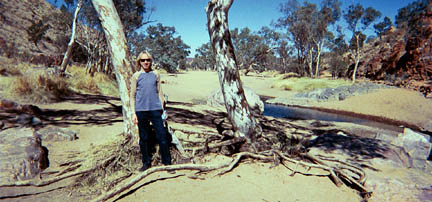The flow of fragile forces
Gail Priest talks with Colin Black

Colin Black
Gary Champion
Colin Black
In Colin Black’s The Ears Outside My Listening Room there is a piece about a city-jack-hammer percussion intercepted by reflective voices, string lines arhythmically mirroring the speech patterns. In one section there is a man’s voice I know. But who is it? There’s a soft intonation, an accent, a subtle huskiness…Voices are burned into my auditory memory rendering them unforgettable long after the names and faces have gone. It bugs me for days.
Ears Outside My Listening Room was created by Black during his 6 month residency with ABC Classic FM’s The Listening Room. The original inspiration came from a recording he had made of his grandfather. “He was talking about his life and he passed away a few years ago and you listen back to this tape, to his voice and in some way it preserves his character. That’s what I wanted to do with all these characters…create a patchwork sonic quilt, something to be passed between generations…the words and voices of the ghosts of tomorrow. Like fingerprints and DNA each of the voices was unique and my hope was that my work would help the detectives of tomorrow understand the spirit of their forefathers. I wanted to create a work that testified to how it feels to be Australian and to live now.”
The 50-minute work is made up of 18 tracks. Each piece is based on a series of interviews conducted by Black, often using ABC remote studios around Australia and ABC archives including Haywire from Triple J’s recordings of stories from young people in regional Australia and old broadcasts. Black has pieced together vignettes around themes—wishes, home, city, weather and sport. What emerges is a comprehensive work made of suggestion, mood and voiceprint character studies that gives a tangible, inclusive and unselfconscious impression of Australian-ness and its many voices. On another level, it highlights the fragility of people, technology and landscape. Black concentrates on “the sub themes of rivers and mortality and trying to preserve things.”
Compositionally the work is particularly interesting in its use of texts and voices as the starting point for the score. Black says, “I composed music around the voices in differing ways…what the people spoke about and how they spoke—the tone of how they said things set up the parameters.” Loops of speech are used as both melodic and rhythmic scores for the instrumentation to follow. The most striking example (and the hit single if there was to be one) is Tony, Kate and Lockette, a retelling of the moment when AFL player Tony Lockette kicked his 1300th goal and the crowd flooded the SCG. Deftly matching the announcer’s voice with a dance beat, the trebly string line sawing and hacking to the melody of the commentators screaming “Lockette! Lockette”, the piece conjures the spirit of the event (even for this dedicated sports cynic). This has a beautiful companion piece in the melancholic reflection of an old man speaking about listening to Donald Bradman playing cricket on the radio—musically conveyed by a slow string adagio.
When the text is used less figuratively, the effect is more atmospheric. Australian Summer Solstice is composed from processed voice samples, creating an audio haze and shimmer like a distant oasis glimpsed on a tarred road. These overlaid with the unfiltered voice of a 70-year old woman talking about her experiences farming the land. A similar effect is achieved in the beautifully abstract Why in which a child describes her love for her doll. The phrase “’cause she speaks” is processed and looped into a kind of pulsing mantra reflecting the childlike (and perhaps not so childlike) desire to bring life to things.
Reinforcing themes of mortality and preservation are the segues between tracks with Ben, a sound archivist simply talking about methods to assist with the hydrolysis of tapes, the preservation of vinyl, and most hauntingly, of being given tapes to digitise containing a recording of his mother as a teenager. These pieces are delicately overlaid with subtle tape hiss, fastforwards and reel noises.
Colin Black hopes that Ears Outside My Listening Room has a continuing life. “I think that people from other countries will find it fascinating, that difference in perspective on what they think is Australian and what they hear from these sort of pieces.” Summer Solstice has already been performed at the 32nd Festival Synthese Bourges 2002 in France and Literature Sound Barrier 2002 in Vienna. He also hopes “to see it incorporated with some visual element, whether it’s dance or visual—audio-visual in the old sense or the new sense of the word, a CD ROM or multimedia event.”
Ears Oustide My Listening Room concludes with The River, composed for vibraphone and the only work not based on vocal lines. The rippling repetition of Jeremy Barnett’s (of the group Prop) vibraphone merges into the concluding statement from the sound archivist about fast forwarding a tape and the air filling with a fine cloud of oxide from the disintegrating tape Ears Oustside My Listening Room is both a celebratory and a melancholic work about the fragility of existence. In its attempts to capture the essence of people and moments in time, it also highlights the desperate futility of trying to preserve what must one day turn to dust.
Colin Black, Ears Outside My Listening Room, made during his New Media Arts Board/ABC Radio Listening Room Fellowship 2002. www1.tpgi.com.au/users/cydonian/outside/ears.html
RealTime issue #52 Dec-Jan 2002 pg. 36






